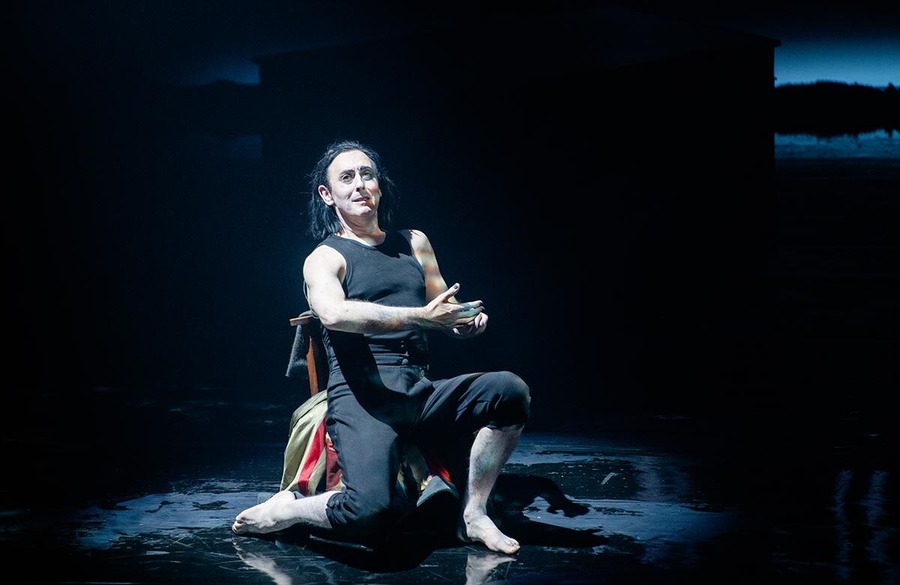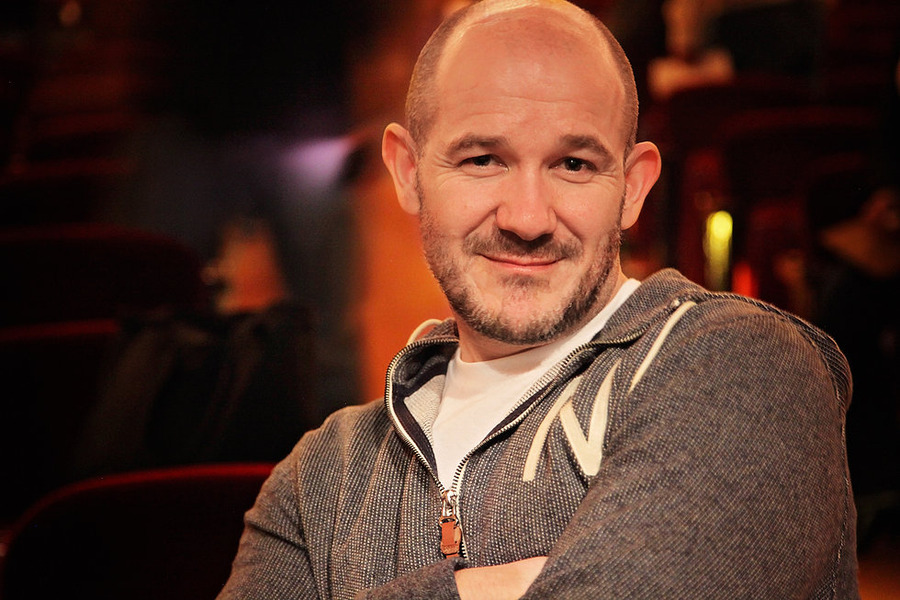Although Burn is a one-man show created by and starring Alan Cumming as the venerated 18th-century Scottish poet Robert Burns, after talking to its co-creator, British choreographer Steven Hoggett, it sounds like it will most enthrall those of us more interested in the physical than the literary.
“We don’t really explore Burns’s poetry, but rather who he was, and how he came to write,” said Hoggett in a recent interview. “And Alan moves throughout the show, from start to finish. Sometimes his movement is low-key, then it lifts up toward peaks and down into troughs, then peaks and troughs again.”
This description probably shouldn’t surprise anyone who’s followed Hoggett’s work as an unconventional movement choreographer, often with the director John Tiffany, with whom he choreographed and associate-directed the National Theatre of Scotland shows The Bacchae (2007), also starring Cumming, and the Iraq War-themed play Black Watch (2006), which garnered Hoggett an Olivier Award for Best Theatre Choreographer. His Broadway credits include American Idiot (2010), Once (2011), Peter and the Starcatcher (2012), and The Curious Incident of the Dog in the Night-Time (2014). He also did fight choreography for the musical Rocky (2014) and served as movement director for Harry Potter and the Cursed Child (2016); this season he’ll do choreography for A Beautiful Noise: The Neil Diamond Musical (starting previews Nov. 2 at Broadway’s Broadhurst Theatre).
Burn is both miles away from most of those credits, and something of a return to his early work. Billed as a dance-theatre piece, and making its U.S. premiere at a New York dance-performance venue, the Joyce Theater Sept. 20-25 after premiering at the Edinburgh International Festival last month, Burn draws its narrative from the poet’s personal letters and is informed by new scholarship suggesting Burns was bipolar.
“Alan and I had an incredible couple of sessions with some Burns academics who made him a figure of complete intrigue for us,” Hoggett explained. “I think what happens with revered figures is that people feel a responsibility toward protecting them. And Burns has come under scrutiny recently because of his womanizing.
“Yet he also suffered from severe mental debilitation. He had periods of excessive output, when his letters were very exuberant, and then you counter that with moments where he can’t speak, he can’t write, he doesn’t talk to anybody, and the tonality of his letters gets very dark.”
It was after talking with the scholars that Hoggett and Cumming, a Scot himself, felt more emboldened about making their own Burns show. They realized there is still so much that even experts don’t know about the revered National Poet of Scotland, and they were encouraged to keep exploring.
“This show is only one particular take on Burns,” Hoggett said. “It’s not heavy with poetry, as we were far more fascinated with how complicated Burns was as a person.” Hoggest also called the show “the most imagistic piece I’ve ever done. It’s very grand and painterly. Even though it’s a one-person show, we were unapologetic about creating massive visual images. There’s a real counterpoint between the individual person and this vast universe exploding behind him as he moves.”
Co-choreographed by Hoggett and Vicki Manderson, a Scottish theatre movement director and former Highland dancer, Burn challenges the very definition of a dance piece. The choreography “takes some of that Highland form, but really puts it through the prism of a contemporary kind of character exploration. It asks the audience to question how broad is ‘dance’ as a term. Yes, Alan does dance,” Hoggett said of the eclectic Cumming, who has tantalized audiences as the Emcee in Broadway’s Cabaret (1998), in a one-man Macbeth (2013), as the creepy host of PBS’s Masterpiece Mystery!, and as a guiding light on the inclusive cabaret scene. “But is this a dance you’re looking at?” Hoggett continued. “No, because we’re not giving Alan any of the usual tropes to work with. The movement all came from exercises that were to do with Burns and his poetry and his life. It came from Alan’s actorly instincts and from Vicki and from myself. It’s a unique language to this piece—a very specific way of moving that wouldn’t happen with anybody else because it’s singular to Alan’s body, and to the three of us working together.”

I first noticed Hoggett’s prowess as a dance-maker when I saw the beautifully rugged choreography he created for the working-class characters in Sting’s Broadway musical The Last Ship in 2014. Yet, surprisingly, the thrice-Tony-nominated Hoggett has never had a formal dance lesson in his life.
“Yes, I have, on occasion, frustrated some people’s minds in terms of being classed as a choreographer,” he admitted. “It’s a tricky territory, and it’s been more pronounced for me in the U.S. than in the U.K. In the U.S. there’s a much stricter sense of what’s dance and what’s not. I create choreographic content that’s not always danced, but it’s movement that flirts with performative values.”
Essentially, the job of a theatrical choreographer consists of two creative components: the generation of movement vocabulary, and the arrangement of that vocabulary into a structure that plays out over time and space. Traditionally, these components are addressed in academic dance programs through courses in, respectively, Movement Improvisation and Dance Composition. In the modern- and contemporary-dance realm, the generation of original vocabulary is highly valued. In musicals, on the other hand, the movements a choreographer arranges may be drawn from familiar vernacular or theatrical dance steps reflective of a show’s characters or setting, and so compositional crafting becomes the more valued choreographic component. But it’s my observation that the most compelling musical-theatre choreography is influenced by the modern dancer’s interest in generating new movement lexicons, and is crafted from fresh vocabulary born directly out of a given cast and creative team’s interpretation of a show’s dramatic elements.
So from where I sit, Hoggett’s ability to spark the generation of new and distinctive movement languages is what makes him a sterling choreographer. To do so, he employs a collaborative, task-driven method stemming from his background in physical theatre. For 18 years, he and Scott Graham co-artistic directed Frantic Assembly, a U.K.-based physical theatre company the pair founded with Vicki Middleton in 1994.
But what exactly is physical theatre?
“There are two ways to answer that question,” Hoggett replied. “First, all theatre is physical, because it asks us to look at the human body in a framework upon which we then project our ideas and thoughts about a story or character. But if I’m being technical, it’s a term that was thrown about in the ’80s and ’90s in the U.K. to refer to theatre where language was the springboard for physical work or expression,” explained Hoggett. “So it wasn’t movement for movement’s sake, or choreography for choreography’s sake. It’s usually rooted in text or text analysis or a response to text. But then you explode the text, so all the ideas become choreographic or movement-based. You ask, what is the subtext, or how can we subvert this, and build exercises that create physicality out of those inquiries.”

For Hoggett, the exercises take the form of tasks that are sometimes what he calls “on the nose”—as when he asked Cumming to create a phrase about how joy feels when his “Burns body” is out in a forest, and what that joy does to him physically. Yet often the tasks are more duplicitous. For a show about Stockholm syndrome, Hoggett tasked a couple with making a tender duet about love and intimacy. “They had to use a tea towel between them as a counterpoint,” he recalled. “Over the five weeks of rehearsal, I kept coming back to it, making them do it harder and faster and harder and faster. By the end, we had a fight, which is exactly what we needed. But you don’t fight in a Stockholm-syndrome situation without there being love at the base of it.
“So sometimes the task is a decoy. If you ask actors for what you want, they’ll run straight to the endpoint and give it to you, but the result may lack substance,” Hoggett continued. “So you sometimes have to send them the wrong way first, so there’s enough of a journey for it to grow a bit more rich.”
Indeed, Hoggett said he is happiest when he’s generating a kind of movement that no one, including himself, has ever done before.
“I had never done a piece about soldiers, or a boxer, and I didn’t know how someone with autism moved,” he said, referring to characters in some of his acclaimed productions. “I like that I’m not the authority in the room, that we find things out together. It makes for an even playing field. Everybody’s got a chance of being right, and that makes people braver.”
In terms of arranging movements into larger compositional structures, Hoggett learned that on the job, inviting prominent contemporary choreographers to collaborate with him in making shows for Frantic Assembly. “We had a brand new choreographer come in every year with a whole new way of moving and thinking, and that was my training. It wasn’t formal, but it was varied, precise, and practical. I didn’t go to a dance school or study theatre in college,” said Hoggett, who holds a degree in English Literature from Swansea University. “But as I worked with the different choreographers I became obsessed with the shapes and the patterning, the use of energy and imagery, and how they moved bodies in space. I started to see how those things generated mood and emotion and intention. I would ask a lot of questions. And because we worked with different choreographers, I got different takes on how to deliver a certain element or feeling or tonality.”
Throughout his career, Hoggett has always been drawn to projects that push him in new directions. Whereas Burn, in many ways, exemplifies his signature approach to theatrical movement-making, his upcoming project, choreographing A Beautiful Noise: The Neil Diamond Musical, is a bit of a departure.
“It’s a straight-up dance show, very presentational, very front-facing, and I’m working with trained dancers, which is very different for me,” Hoggett said. “I’m elated to be working on it—to feel I’m still being encouraged to take new risks and put in a room with people who’ll take them with me.”
Lisa Jo Sagolla (she/her), a New York-based arts critic, is the author of The Girl Who Fell Down: A Biography of Joan McCracken and Rock ’n’ Roll Dances of the 1950s. She teaches at Columbia University’s Teachers College and Rutgers University, and is currently researching a chapter on the Broadway musical Timbuktu! for a new book on Geoffrey Holder.


